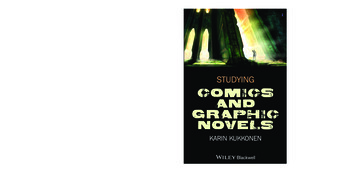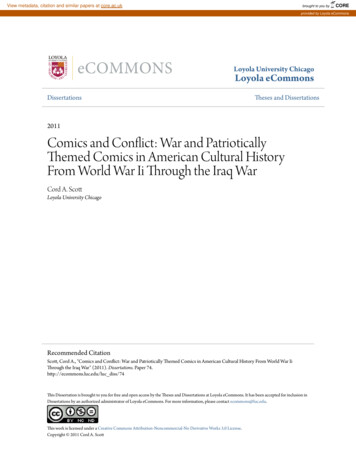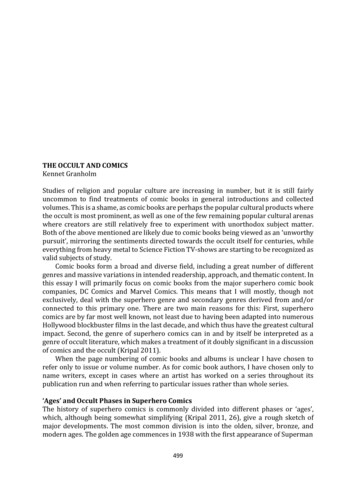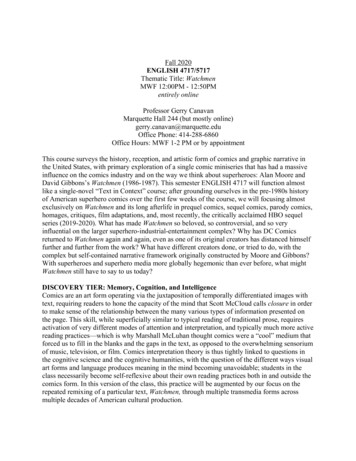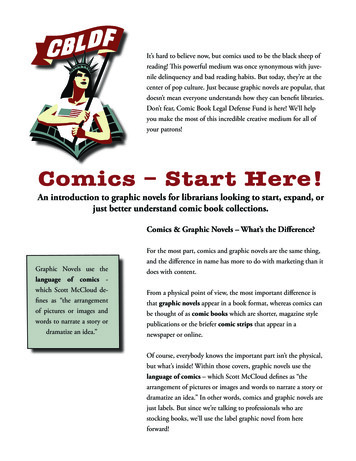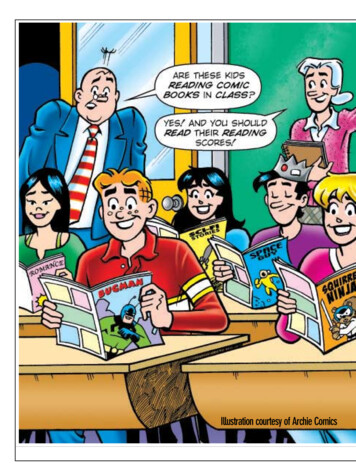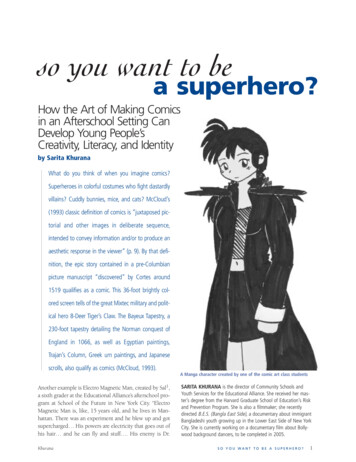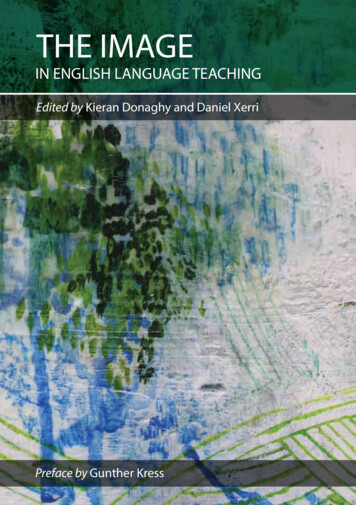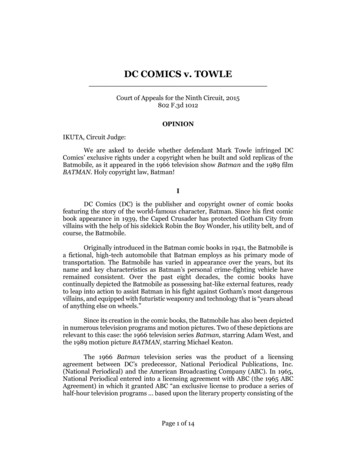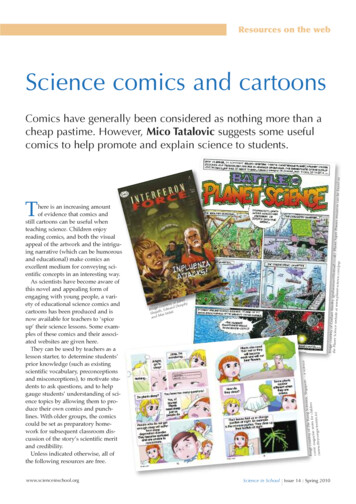
Transcription
Resources on the webScience comics and cartoonsImage courtesy of Graham Manley (grahamman@hotmail.co.uk). Planetthe Planet Science webSuper Powers resourcessite at www.planet-scienccan be found one.com/pspComics have generally been considered as nothing more than acheap pastime. However, Mico Tatalovic suggests some usefulcomics to help promote and explain science to students.Twww.scienceinschool.orglJaleeyy ofurtes d DunphocerImag , EdwathjatiuShVelaMaxand– a scienceentists, Singaporeof The Young SciImage courtesyenldrchiforseriescomic magazinegscientists.in)(www.theyounhere is an increasing amountof evidence that comics andstill cartoons can be useful whenteaching science. Children enjoyreading comics, and both the visualappeal of the artwork and the intriguing narrative (which can be humorousand educational) make comics anexcellent medium for conveying scientific concepts in an interesting way.As scientists have become aware ofthis novel and appealing form ofengaging with young people, a variety of educational science comics andcartoons has been produced and isnow available for teachers to ‘spiceup’ their science lessons. Some examples of these comics and their associated websites are given here.They can be used by teachers as alesson starter, to determine students’prior knowledge (such as existingscientific vocabulary, preconceptionsand misconceptions), to motivate students to ask questions, and to helpgauge students’ understanding of science topics by allowing them to produce their own comics and punchlines. With older groups, the comicscould be set as preparatory homework for subsequent classroom discussion of the story’s scientific meritand credibility.Unless indicated otherwise, all ofthe following resources are free.Science in School Issue 14 : Spring 2010
General scienceNewton and CopernicusThese are short comic strips about two lab rats whose conversations can motivate students to think about scienceand research: www.newtonandcopernicus.comA description of how to use these cartoons in theclassroom can be found at: www.csun.edu/ jco69120ScientoonsIndian scientist and science communicator PradeepSrivastava has created cartoons embedding new research,ideas, data or scientific facts within the caricatures, satirical comments or dialogue: www.scientoon.comImage courtesy of Pradeep Srivastavaphotocopiable cartoons or a CD-ROM, from: www.conceptcartoons.com/index flash.htmlThe Young ScientistsThis comic book magazine, aimed at 5-13-year-olds, communicates science and the life stories of great scientistsand promotes creative thinking and practical experimentalskills. You can order the books and download sampleissues from: www.theyoungscientists.in/products.htmlMax AxiomThese comics cover a variety of topics from electromagnetism to natural selection and are aimed at students aged 814. They feature the superhero Max Axiom who ‘will dowhatever it takes to make science super cool and accessible’. Copies can be ordered yGUID 8bd6f56b-a478-44aa-ba47-93b69dce0b27Jim Ottaviani’s comics and graphic novelsNuclear engineer Jim Ottaviani’s comics includeDignifying Science (why women are underrepresented inscience), Suspended in Language (Niels Bohr’s life and scientific discoveries), Fallout (science and politics of the firstatomic bombs), Two-fisted Science (the history of science),(www.savoir-sans-frontieres.com)Image courtesy of Jean-Pierre PetitPlanet Super PowersCreated by Planet Science, The Battle for the Planet Sciencecomic includes a competition to ‘engineer’ your ownsuperhero. A teacher’s pack and activities are also available: www.planet-science.com/randomise/index.html?page /psp/home.html&page /psp/index.htmlThe Adventures of Archibald HigginsThis adventure series is the brainchild of French astrophysicist Jean-Pierre Petit, and the comics cover manyadvanced science topics in many languages:www.savoir-sans-frontieres.comConcept CartoonsThese are single-frame cartoons that depict a single problem, such as ‘Would a snowman melt faster, slower or atthe same rate if we put a coat around it?’. Offering noimmediate solution, these cartoons make students thinkabout the problem and discuss it. There are a few freeexamples online and the complete collection can beordered in English and Welsh, as books, posters,Science in School Issue 14 : Spring 2010www.scienceinschool.org
Resources on the webLevitation (psychics and psychology of magic), WireMothers: Harry Harlow and the Science of Love (the science oflove) and Charles R. Knight: Autobiography of an Artist (thestory of an artist whose paintings influenced 20th centuryscientific fact and fiction). The books can be ordered from:www.gt-labs.comMedikidzBig Time Attic comics and graphic novelsJay Hossler’s comics and graphic novelsZander and Kevin Cannon have illustrated non-fictiongraphic novels such as Bone Sharps, Cowboys and ThunderLizards (scientists who discovered dinosaur fossils), TheStuff of Life (all about DNA) and T-Minus: The Race to theMoon (astronomy). Their books can be ordered from:www.bigtimeattic.comBiology, health and medicineInterferon ForceAn exciting story about the battle between the immunesystem’s interferon molecules and flu viruses. Free hardcopies are also available from: www.interferonforce.comA group of five superheroes are followed on a journeyaround Mediland (the human body) so that young peoplecan learn about medical issues. The books can be orderedvia the website, which also provides additional resourcesfor children on medicine: www.medikidz.comJay Hossler, Assistant Professor of Biology at JuniataCollege, Huntington, Pennsylvania, USA, has written andillustrated graphic novels such as Clan Apis (bee behaviour), Sandwalk Adventures (how natural selection worksand how it differs from creation stories) and OpticalAllusions (eye biology and evolution). You can read someof the shorter comics online and order the graphic novelsfrom his website: www.jayhosler.comImage courtesy of Jaleel Shujath, Edward Dunphy and Max VelatiAdventures in Synthetic BiologyA good introduction to genetic modification and similartopics, available in English and Spanish: http://openwetware.org/wiki/AdventuresThe Conundrum of the Killer CoronavirusA two-page comic all about severe acute respiratorysyndrome (SARS): /14.1.3.pdfWorld of VirusesGraphic novels developed by the University of Nebraskain Lincoln, Nebraska, USA, which each present advancedscientific material about various viruses. You can download a sample and order the books here: riends Forever – A Triumph Over TBA story illustrated in comic form for patients withtuberculosis, which aim to raise awareness of the atient-comicbook.pdfLuís Figo and The World Tuberculosis CupAn educational comic book featuring a celebrity footballerand his support of the Stop TB Partnership to raise awareness of tuberculosis: FigoComicBook ENG low res.pdfX-Men Life LessonsThis comic book can be used to help young people whohave survived serious burn injuries, and comes with adiscussion booklet: ocomicIn 2009, the Centre d’Investigació Cardiovascular(Cardiovascular Research Centre, CSIC-ICCC) inBarcelona, Spain, ran its first competition for school students to draw cartoons about cardiovascular disease. Youcan find the cartoons in Spanish and Catalan, as well asdetails on the 2010 competition, here: http://cardiocomic.blogspot.comScience in School Issue 14 : Spring 2010
The Spanish ‘Menudos corazones’ foundation for childrenand young people with cardiopathies has edited threecomics on the topic to help these youngsters cope betterwith their situation: www.menudoscorazones.org/index.php?option com content&task view&id 295&Itemid 122&lang esChemistrySeleniaImages courtesy ofEric Pailharey & FredVignaux / ESAMenudos corazonesThis chemistry comic series is designed to teach chemistryto pupils aged 7-10. Each issue covers a single subject, hasan engaging narrative that explains the science involved,and features a glossary explaining the scientific terms:www.sciencecomics.uwe.ac.ukVladimir PrelogA Croatian chemistry comic: g strip.pdfPhysics, astronomy and space scienceCassini-Huygens: a probe to TitanOn 14 January 2005, the European probe Huygens enteredthe atmosphere of Titan – one of Saturn’s moons. Basedon this major event in space exploration, the EuropeanSpace Agency (ESA) has developed a comic book withsupporting fact sheets for teachers to use in the classroom.They are available in Dutch, English, Finnish, French,German, Spanish and Swedish. See: www.esa.int/SPECIALS/Education/SEM6ZC9FTLF 0.htmlCindi in SpaceA superhero style comic about the ionosphere andsatellites, available in English and Spanish: http://cindispace.utdallas.edu/education/cindi comic.htmlThe STEL MangasThe Solar-Terrestrial Environment Laboratory (STEL) ofNagaya University in Japan has produced a series of eightManga comics on topics such as global warming, solarradiation, geomagnetism and cosmic rays. The comics arefreely available in English and Japanese and for translation into other languages: tml#anc bookletsScience in School Issue 14 : Spring 2010www.scienceinschool.org
Resources on the webEnvironmental issues and agricultureOzzy OzoneProduced by the United Nations EnvironmentProgramme, this interactive comic provides informationand activities about the ozone layer, environment, climatechange and the atmosphere: www.ozzyozone.orgEco AgentsAn interactive online comic created by the EuropeanEnvironmental Agency to engage students with topicssuch as ecology and sustainable energy: http://ecoagents.eea.europa.euBorn in Rijeka, Croatia, Mico Tatalovic did a bachelor’sdegree in biology at Oxford University, UK, and then amaster’s in zoology at Cambridge University. While working on Cambridge University’s BlueSci magazine, hedeveloped a love for science writing and went on to do amaster’s in science communication at Imperial College,London. Mico is currently a freelance science writer.Science StoriesComic stories from the Rothamsted Research Institute, anagricultural research centre in Harpenden, UK, depictingresearchers from the institute, in cartoon form, describingtheir areas of research: www.rothamsted.ac.uk/schools/ScienceStoriesWater HeroesA comic story and associated teaching activities producedby Environment Canada to teach students about freshwater ecosystems and conservation: using comics in the science classroomThe following articles offer suggestions on how to usecomics in the science classroom.Keogh B et al. (1998). Concept cartoons: a new perspectiveon physics education. Physics Education 33: 219-224Tatalovic M (2009) Science comics as tools for science education and communication: a brief, exploratory study.Journal of Science Communication 8: A02. Free access 009%29A02/?searchterm NoneVilchez-Gonzales JM, Palacios, FJP (2006) Image of sciencein cartoons and its relationship with the image incomics. Physics Education 41: 240-249Weitkmap E, Buret F (2007). The Chemedian bringslaughter to the chemistry classroom. International Journalof Science Education 29: 1911-1929ResourcesIf you found this article helpful, you may like to readthe other ‘Resources on the web’ articles published inScience in School. See: Science in School Issue 14 : Spring 2010
You can read some of the shorter comics online and order the graphic novels from his website : www.jayhosler.com Cardiocomic In 2009, the Centre d’Investigació Cardiovascular (Cardiovascular Research Centre, CSIC-ICCC) in Barcelona, Spain, ran its first competition for school stu -
